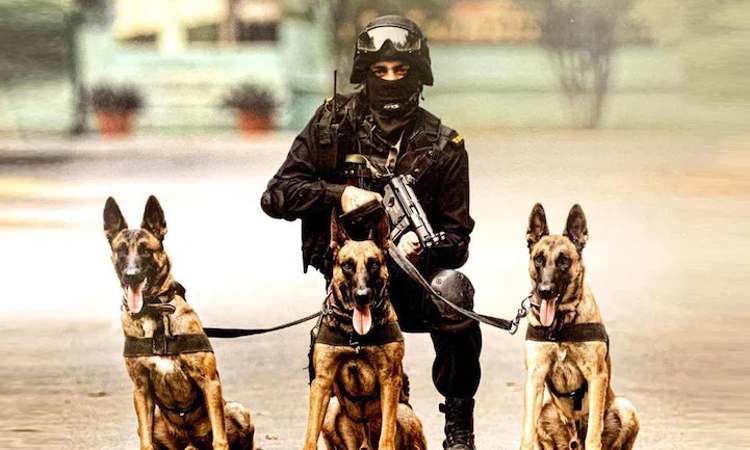- Home
- /
- High Courts
- /
- Orissa High Court
- /
- Police Dog Cannot Testify In Court,...
Police Dog Cannot Testify In Court, Its Handler's Evidence Is Mere Hearsay And Requires Corroboration: Orissa High Court
Jyoti Prakash Dutta
1 April 2025 5:18 AM
The Orissa High Court has upheld a two-decade-old order passed by the Court of Adhoc Additional Sessions Judge, Bhubaneswar whereby it had acquitted two persons accused of committing rape and murder of a minor girl in the year 2003.The Division Bench of Justice Bibhu Prasad Routray and Justice Chittaranjan Dash discarded the evidence of the sniffer dog which pointed at the shop of one of...
The Orissa High Court has upheld a two-decade-old order passed by the Court of Adhoc Additional Sessions Judge, Bhubaneswar whereby it had acquitted two persons accused of committing rape and murder of a minor girl in the year 2003.
The Division Bench of Justice Bibhu Prasad Routray and Justice Chittaranjan Dash discarded the evidence of the sniffer dog which pointed at the shop of one of the accused, following a scent trail. It reasoned,
“...since the dog cannot testify in court, its handler must provide evidence regarding the dog's behaviour. This introduces a layer of hearsay, as the handler is merely interpreting the dog's reactions rather than providing direct evidence. The dog is a mere “tracking instrument” rather than a witness, with the handler reporting the dog's behaviour. The police dog evidence, in the instant case, is unreliable in the absence of corroboration.”
Case Background
On the night of May 01, 2003, the pratistha ceremony of a newly constructed Siva Temple was being undertaken near the river embankment in the village of Gangeswarpur Sasan. During the night, children from the village, including the deceased, were playing near the said temple. As the night progressed, the other children returned home, but the minor deceased girl did not return.
A search was conducted throughout the night by the villagers, but the deceased could not be traced. Early in the next morning, her dead body was discovered from a dried pond amidst bushes near the temple. The body had visible injuries on the cheek, neck, private parts and other areas. Subsequently, an FIR was lodged for commission of offences under Sections 364, 376(2)(f), 302 and 34 of the IPC.
Upon completion of the investigation and finding a prima facie case against the accused/respondents, a charge sheet was filed against them. However, after a thorough trial, the trial Court was of the view that the prosecution failed to establish a complete chain of circumstances leading towards the guilt of the accused and therefore, acquitted them of the charges. The State filed this appeal seeking leave to challenge the acquittal.
Last seen theory not reliable
After perusing the case records and hearing the counsel for the parties, the Court analysed the evidence sought to be proved against the accused persons. As the case is based solely on circumstantial evidence, the prosecution heavily relied upon the 'last seen circumstance' to bring home the charges against the accused persons.
A minor boy deposed to have seen the deceased girl for the last time in the company of the first respondent. But after examining the said evidence, the Court was of the considered view that the same failed to meet the standards required for invoking the 'last seen doctrine'.
“P.W.2 initially stated that during the pratistha ceremony, at around 9:00 p.m., he saw Respondent No.1 calling the deceased towards Tikarpada village while she was standing on the river embankment. However, during cross-examination, P.W.2 admitted that due to the darkness, he could not see much and eventually went home. Importantly, P.W.2 later turned hostile, thereby weakening the prosecution's case,” it held.
Moreover, the Court said that the time gap between the alleged last sighting and the discovery of the corpse is substantial, leaving ample scope for the involvement of any other person. The absence of any direct evidence placing the respondents with the deceased immediately before her death, it held, breaks the chain of circumstances necessary for applying the last-seen theory.
Suspicious behaviour is attributable to intoxication
The prosecution also highlighted the suspicious behaviour exhibited by the first respondent following the incident. It was alleged that while the whole village was mourning the unfortunate death of the minor deceased, the first respondent opened his shop but was suspiciously inattentive. Also, despite of knowing about the missing status of the deceased, he did not participate in the search in which the entire village got involved in.
However, the Court was not convinced to accept such behaviours as relevant factors to fasten criminal liability against the first respondent.
“Mere non-participation in the search for a missing person does not automatically lead to the inference of guilt unless it is coupled with other incriminating circumstances forming a complete chain of evidence. In the present case, there is no concrete evidence linking Respondent No.1's conduct during the search to the crime. His behaviour, while arguably indifferent or inappropriate, cannot be deemed sufficient to establish guilt beyond reasonable doubt.”
Though the prosecution argued that the conduct of the first respondent was mischievous and erratic, but the Court inferred that such behaviour can be attributed to his habit of consuming ganja (cannbis) and thus, his strange behaviour was a result of intoxication rather than his involvement in any criminal activity.
“Without any substantive evidence, interpreting these actions as an indication of guilt is speculative and unwarranted. The prosecution's attempt to construe Respondent No.1's conduct as indicative of guilt fails to meet this standard. The possibility that his behaviour resulted from his known habit of consuming ganja, rather than any involvement in the crime, is a reasonable alternative hypothesis that cannot be ruled out.”
Rapes committed by the accused in past not relevant
Above all, the evidence adduced from another minor witness was vehemently placed before the Court to show that the main accused did not commit such offence for the first time, rather he had committed rape with three other minor girls of the village in the past. Despite of such criminal behaviour, the villagers had allowed him to escape criminal prosecution after giving warnings.
“…the notion that a serious crime such as rape could be resolved informally within the village, without any formal action, seriously questions its credibility. It is unlikely that such a grave offense would be quietly settled, especially considering the gravity of the allegation… Mere rumours or village gossip cannot form the basis for conviction without concrete evidence,” the Court observed while brushing aside such evidence.
Sniffer dog's evidence not reliable
The State highlighted the fact that the service of a sniffer dog was requisitioned, which was made to smell the crime scene and the smell led the animal not only to the dead body of the deceased but also to the shop of the first respondent. It was alleged that after coming near the shop of the accused, the dog stopped and started running around the same.
But the Bench relied upon the observations made by the Apex Court in Abdul Rajak Murtaja Dafedar v. State of Maharashtra (1969) to hold that the investigation lacked critical elements while assessing the police dog evidence.
“The prosecution did not present evidence of the dog's training, skill, or past performance to establish its reliability. No forensic evidence, such as fingerprints, bloodstains, or incriminating materials, was recovered from the locations identified by the dog. The prosecution failed to demonstrate that the conditions under which the dog conducted the tracking were controlled or that there were no other scent trails that could have confused the animal,” it held.
So far as culpability of the second accused/respondent was concerned, the Court held that mere association with the principal accused is insufficient to establish his guilt. Since no independent evidence linked him to the crime, he has rightly been acquitted of the charges.
Resultantly, the order of acquittal in favour of both the accused/respondents passed by the trial Court was upheld.
Case Title: State of Odisha v. PKD & Anr.
Case No: CRLLP No. 53 of 2006
Date of Judgment: March 26, 2025
Counsel for the Appellant/State: Mr. S. B. Mohanty, Additional Government Advocate
Counsel for the Respondents: Ms. A. Mishra, Advocate for Respondent No.1; Mr. P. Jena, Advocate for Respondent No.2
Citation: 2025 LiveLaw (Ori) 60
Click Here To Read/Download Order

